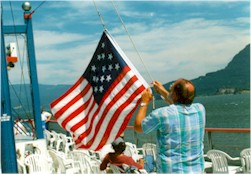|
The boat passed through the narrows of the Columbia that the Indians told had been spanned once by the graceful Bridge of the Gods. Reaching bigger water as the green cliffs lean away from the blue water a man unfolds the familiar yet unusual flag, attaches it to a lanyard, and hoists it aloft. The moment becomes the last day of October, 1805, when Lewis and Clark pushed their dugouts past this place flying that flag. William Clark wrote "Stumps of pine trees are in maney places at Some distance in the river, and gives every appearance of the rivers being damed up below from Some cause which I am not at this time acquainted with." As the now nearly-extinct California Condor circled overhead, an Indian swam to the brink of the violent suck of the "Great Shute" to retrieve a wounded goose. Clark noted, "this Indian richly earned the goose I Suffered him to keep it." The fallen Bridge of the Gods had dammed the River of the West centuries earlier; now, under the bright sun and the same fifteen-star flag flown by Lewis and Clark, we try to imagine what the Corps of Discovery had seen.
Learn more about Bridge of the Gods
located in the Columbia Gorge National Scenic Area |
|
|||||||||||||
|
|
|||||||||||||||


